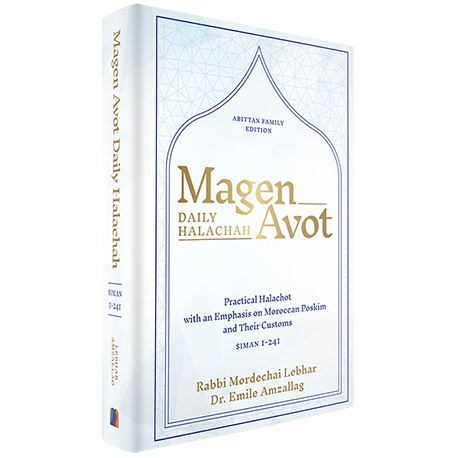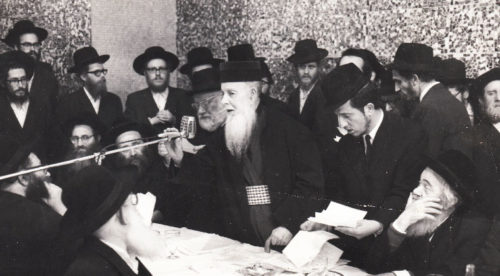Halachot in the tradition of our Chachamim from Morocco
Dozens of Audio & Video Shiurim by Rabbi Mordechai Lebhar
Hilula of Moroccan Tzadikim
Sefarim based on our Morrocan Minhagim
Monthly Sponsor: Available
Weekly Sponsor: Available
Sponsor of the Day: Available

Magen Avot - Daily Halacha
Click here to purchase
Daily Moroccan Halachot
Rabbi Mordechai Lebhar, author Magen Avot
Redacted by Dr. Emile Amzallag
DAILY HALACHOT PODCAST  ON APPLE
ON APPLE  ON SPOTIFY
ON SPOTIFY
Daily Halachot Topics
In addition to Netilat Yadaim for bread, the Shulhan Aruch (Orah Haim 158:4) rules that whenever one eats food dipped into or wet by certain liquids, one must wash one’s hands without a blessing. These liquids are wine, honey, oil, milk, dew, blood (such as fish blood, which the Torah allows, but is prohibited because ofMarit Ayin, ie. how it will be perceived) and water, because these liquids have the capacity to transmitting impurity. The Rama (ibid.) goes further and says that only if the tip of the food is being dipped and one’s hands will remain dry, one still must wash. Even though the laws of ritual purity have been suspended, there is still a virtue of eating food in a state of holiness. As such, one who eats a wet apple, for example, would need to wash prior to eating it. Additionally, this is why one washes one’s hands without a blessing for the Karpas segment of the Seder, since it involves a vegetable being dipped into a liquid. Nevertheless some Rishonim, including the Maharam of Rothenberg, are lenient with regards to this type of washing. As well, Rabbi Shalom Messas (Shu”t Shemesh Umagen, vol. 2, § 45:3) and Rabbi Shlomo Zalman Auerbach write that the custom nowadays is to be lenient. Rabbi David Ovadia (Nahagu Ha’am, Hilchot Berachot), on the other hand, writes that one may be lenient only if a segment of the food is wet but the portion that one is holding is still dry, such as dipping a tip of a cookie into tea. Summary: Although the Halacha is that one must wash one’s hands without a blessing when eating wet foods, there were many lenient opinions. Summary: Hand-made Matza should be used for the different Mitzvot at the Seder (Achilat Matza, Korech, Afikoman). Machine-made Matza may be used for the actual meal and for the rest of Pesah so long as they have a reliable Hechsher. Summary: According to the Moroccan custom, rice is not permitted onPesah. Although not expressly forbidden, the custom is to avoid otherKitniyot as well. Pyrex and Duralex are proprietary names of glass-based materials commonly used in kitchenware which are produced in such a manner which allows them to be heat-resistant. Although some are of the opinion that they have earthenware-like properties (see previous Halacha), Rabbi Ben Zion Abba Shaul (Or LeZion vol. 3, ch. 10) says that they have the same status as glass and simply need to be cleaned before Pesah. Another area of concern in the kitchen are modern stove-tops which are made of a glass-ceramic material. According to the Institute of Science and Halacha (Israel), the crystallization method of this material gives it ceramic properties, namely hardness, yet it is still non-porous just like glass. Therefore, with regards to koshering for Pesah, they have the same status as glass. The part of the stove-top occupied by the elements are of least concern since they can be turned on and koshered through the process of Libun. Regarding the peripheral areas of the stove-top, Rabbi Levi Yitzchak Halperin of the Institute suggests that one pour boiling water on it three times from a primary heat source (such as an electric kettle). Alternatively, one can cover the stove-top with aluminum foil, excluding the actual elements. Summary: Pyrex has the status of glass and only needs to be cleaned forPesah. The area of glass-ceramic stove-tops excluding the burners can be cleaned by pouring boiling water on it three times. Alternatively those areas can be covered with aluminum foil. While discussing an earthenware vessel in which sacrifices were cooked, the Torah (Vayikra 6:21) and the Gemara (Pesahim 30b) explain that such a vessel can not be cleansed by conventional immersion into a Mikve, and that only breaking the vessel will render the resultant pieces pure. By extension, the Shulhan Aruch (Orah Haim 451:1) says that an earthenware vessel in which hotHametz was cooked throughout the year cannot be koshered by Haga’ala(immersion into boiling water). Although Libun (heating with a flame) would technically work, there is a concern that one would not do it to a satisfactory level out of fear of bursting the vessel. However, placing such a vessel into a kiln, or nowadays, a self-cleaning oven, would render it kosher for Pesah, albeit with the risk of shattering. It should be noted that aforementioned laws apply to both glazed and unglazed earthenware. Unlike porous earthenware which has the capacity of absorbing residual Hametz, the Shulhan Aruch (Orah Haim 451:26) rules that glass is not absorptive. Therefore, the Sephardic custom, including that of the Moroccan community, is that glass need only be cleaned for use on Pesah. Summary: Unless one uses the heat of a self-cleaning oven, earthenware vessels cannot be koshered for Pesah. Glass vessels require no special koshering. The day after Pesah, Shavuot and Sukkot is known as Isru Hag. The Gemara (Sukkah 45b) expounds the verse that is sung in the Hallel “Isru Hag Ba’Avotim Ad Karnot HaMizbeah” to mean that one who treats the day after the holiday festively, is considered to have brought a sacrifice to the Bet HaMikdash. Furthermore, the Yerushalmi (Avoda Zara 1:5) refers to Isru Hag as “Bere DeMoada” (lit. “child of the holiday”) on which it was customary to eat a festive meal. The Rama (Orah Haim 429:2) states that one should treat this day as a semi-holiday by eating and drinking. Indeed, Rabbi Yosef Benaim (Noheg BeHochma, pg. 34) explains that the custom in the city of Fes was to refrain from work on Isru Hag. The Ben Ish Hai (Rav Pe’alim, vol. 2, Sod LeYesharim § 1) states that this was the custom in Baghdad as well, but only on the Isru Haf of Pesah and Sukkot, but not Shavuot. The prevalent custom nowadays is to work on Isru Hag. Furthermore there is a custom to recite the Mizmor “HaShamaim Mesaperim Kevod E-l” and the verses “Ana Hashem Hoshia Na, Ana Hashem Hatzliha Na”. Summary: Isru Hag has a semi-festive character. The day after the last day of Yom Tov is known as Isru Hag and has the status of a minor holiday . There was a custom in Morocco on Isru Hag of Shavuot to gather and bury any Torah scrolls, holy books and holy objects that needed to be buried. When such articles become invalid or unusable, they must be disposed of in a special manner. Since this type of disposal shows honor to the Torah and holy objects, it is fitting to perform the burial after the holiday commemorating our receiving the Torah. Most communities nowadays have a Genizah service in which holy articles can be stored and one should be aware of the intrinsic holiness of even Torah pamphlets, bulletins, etc. One who has the practice of fasting on the Nahala (Yartzheit) of a family member should not fast if the Nahala falls on Isru Hag, and should postpone it to another day. Finally, the book Arba Gevi’im discusses a custom to read the books of Iyov, Mishle and Daniel before Minha on the Shabbatot between Shavuot and Tisha B’Av. Summary: Isru Hag has some properties of Yom Tov. One should be aware of certain articles that may need proper Genizah/disposal if they become unusable. Rabbi Moshe Karp (Hilchot Hag BeHag) writes that women nowadays are not considered subordinate to their husbands as they were in generations past, and thus they too can express their freedom by leaning. Furthermore, many families hire help, which would allow women to more fully participate in the Seder, including leaning. Rabbi Haim Benveniste (Pesah Me’uvin, § 3), Rabbi Ben Zion Abba Shaul (Or LeZion, vol. III , ch. 15), Rabbi Ovadiah Yosef (Hazon Ovadiah Pesach) and other rabbis concur with this approach. One practical difference between men and women is if one forgot to lean when drinking wine or eating Matza. If a man does so, he does not fulfill his obligation and must go back and repeat the Mitzvah while leaning. However, since the Shulhan Aruch says that women are exempt from leaning and the original custom was as such, it appears that a woman would not have to repeat the glass of wine or Matza if she forgot to lean, and would have fulfilled her obligation Bediavad (ex post facto). Summary: Nowadays, women should lean at the appropriate times during the Seder. A women does not have to go back and drink another glass of wine or eat Matzah while leaning if she forgot to lean the first time.Washing with Dipped Foods
How is Hametz Sold?
May One Eat Machine-Made Matza?
Is Rice Permitted on Pesah?
Koshering Glass Stovetops
Koshering Earthenware and Glass for Pesah
How did Moshe Kill the Egyptian?
What is Isru Hag?
What are Some Customs of Isru Hag?
Haseva: Are Women Obligated?
The Gemara (Pesahim 120a) discusses the idea of women leaning and the early Poskim give different reasons as to why women may be exempt. The Rashbam (Pesahim 108a, sv. “Isha”) explains that a woman’s awe and subservience to her husband would exempt her from Haseva. The Sheiltot writes that it is not the nature of women to lean, while the Ran explains that a woman serves her husband and thus she is not fully free.
Sign up for the Daily Moroccan Halachot Email


